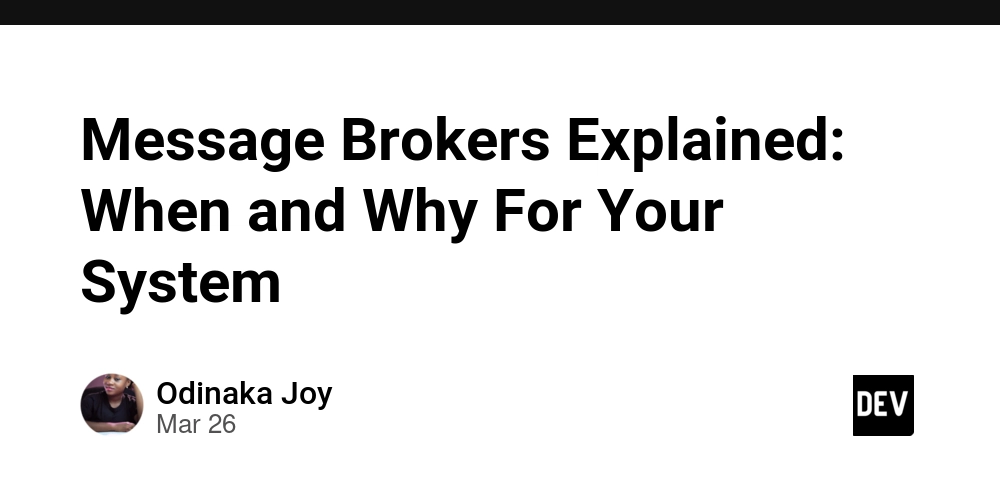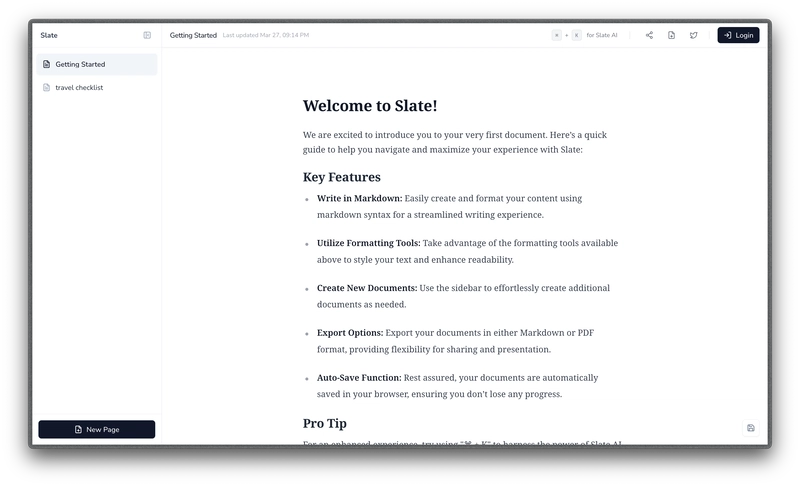Message Brokers Explained: When and Why For Your System
As I have been diving deeper into systems design, I have come across a concept that I think often causes confusion for many (including me) — Message Brokers. I decided to write this down, both as a reference for my future self and for anyone else trying to understand why and when to use them. When Do You Use Message Brokers? What is a Message Broker? A message broker (also known as a queue or message queue) is an intermediary system that allows different applications or services to communicate with each other by sending and receiving messages. It acts like a middleman that separates the sender (the app sending the message) from the receiver (the app getting the message). This makes the system more flexible and easier to grow. Message brokers are key components in systems that need to handle asynchronous communication, manage queues of messages, or route data between services in a reliable way. When to Use a Message Broker? Here are some scenarios where a message broker is useful: 1. Decoupling of Systems or Services Use case: When you want different parts of your system (e.g., microservices) to communicate without being tightly coupled. Why: A message broker ensures that services can operate independently and communicate via messages, reducing dependencies between components. Example: In a microservices architecture, one service might send user registration data to a broker, while another service (e.g., email) picks up the message and sends a welcome email. 2. Asynchronous Communication Use case: When you need to send messages without expecting an immediate response. Why: Message brokers store messages in queues, so consumers can process them later, without blocking the sender. Example: An e-commerce platform sends order data to a message broker, and backend systems process the order later, without delaying the customer’s checkout process. 3. Load Balancing Use case: When you need to distribute workloads evenly across multiple workers or services. Why: A message broker can distribute messages to multiple consumers to ensure no single service gets overwhelmed. Example: A data processing system sends jobs to a queue, and multiple workers can process those jobs in parallel. 4. Reliability and Fault Tolerance Use case: When you need to ensure messages are not lost, even in case of system failures. Why: Message brokers often provide message persistence, meaning messages stay in the queue until they are successfully processed. Example: In a financial system, transactions can be stored in a message broker to ensure that even if a processing system goes down, transactions are not lost. 5. Event-Driven Architecture Use case: When you want your system to react to specific events (e.g., new user registrations, order completions). Why: A message broker acts as a central hub where events are published and different services can subscribe to react accordingly. Example: When a user updates their profile, the message broker notifies services like email, notification, and analytics to perform their respective tasks asynchronously. 6. Handling High Throughput or Burst Traffic Use case: When your system experiences sudden traffic spikes. Why: Message brokers help smooth out high traffic by queuing incoming requests and processing them at a manageable rate. Example: An online event ticketing platform could use a message broker to queue incoming purchase requests and process them gradually, avoiding system overload. 7. Message Routing Use case: When you need to route messages to specific consumers based on message content or conditions. Why: Message brokers can implement advanced routing features, such as topic-based or content-based filtering, ensuring messages reach the right service. Example: In a multi-service payment system, a message broker can route payment messages to different services like fraud detection, invoicing, or reporting. 8. Cross-Platform Communication Use case: When you need different services written in different languages or running on different platforms to communicate. Why: Message brokers typically support a variety of protocols and message formats, making it easy for heterogeneous systems to work together. Example: A Java-based legacy system can communicate with a newer Python-based microservice using a message broker like RabbitMQ or Kafka. 9. Data Aggregation or Real-Time Processing Use case: When you need to collect data from multiple sources and process it in real-time. Why: Message brokers facilitate the collection of data streams from multiple sources and allow real-time processing as messages are consumed by different services. Example: A monitoring system collects data from various IoT devices. A message broker processes this data in real-time, triggering alerts based on specifi

As I have been diving deeper into systems design, I have come across a concept that I think often causes confusion for many (including me) — Message Brokers. I decided to write this down, both as a reference for my future self and for anyone else trying to understand why and when to use them.
When Do You Use Message Brokers?
What is a Message Broker?
A message broker (also known as a queue or message queue) is an intermediary system that allows different applications or services to communicate with each other by sending and receiving messages. It acts like a middleman that separates the sender (the app sending the message) from the receiver (the app getting the message). This makes the system more flexible and easier to grow.
Message brokers are key components in systems that need to handle asynchronous communication, manage queues of messages, or route data between services in a reliable way.
When to Use a Message Broker?
Here are some scenarios where a message broker is useful:
1. Decoupling of Systems or Services
- Use case: When you want different parts of your system (e.g., microservices) to communicate without being tightly coupled.
- Why: A message broker ensures that services can operate independently and communicate via messages, reducing dependencies between components.
Example:
In a microservices architecture, one service might send user registration data to a broker, while another service (e.g., email) picks up the message and sends a welcome email.
2. Asynchronous Communication
- Use case: When you need to send messages without expecting an immediate response.
- Why: Message brokers store messages in queues, so consumers can process them later, without blocking the sender.
Example:
An e-commerce platform sends order data to a message broker, and backend systems process the order later, without delaying the customer’s checkout process.
3. Load Balancing
- Use case: When you need to distribute workloads evenly across multiple workers or services.
- Why: A message broker can distribute messages to multiple consumers to ensure no single service gets overwhelmed.
Example:
A data processing system sends jobs to a queue, and multiple workers can process those jobs in parallel.
4. Reliability and Fault Tolerance
- Use case: When you need to ensure messages are not lost, even in case of system failures.
- Why: Message brokers often provide message persistence, meaning messages stay in the queue until they are successfully processed.
Example:
In a financial system, transactions can be stored in a message broker to ensure that even if a processing system goes down, transactions are not lost.
5. Event-Driven Architecture
- Use case: When you want your system to react to specific events (e.g., new user registrations, order completions).
- Why: A message broker acts as a central hub where events are published and different services can subscribe to react accordingly.
Example:
When a user updates their profile, the message broker notifies services like email, notification, and analytics to perform their respective tasks asynchronously.
6. Handling High Throughput or Burst Traffic
- Use case: When your system experiences sudden traffic spikes.
- Why: Message brokers help smooth out high traffic by queuing incoming requests and processing them at a manageable rate.
Example:
An online event ticketing platform could use a message broker to queue incoming purchase requests and process them gradually, avoiding system overload.
7. Message Routing
- Use case: When you need to route messages to specific consumers based on message content or conditions.
- Why: Message brokers can implement advanced routing features, such as topic-based or content-based filtering, ensuring messages reach the right service.
Example:
In a multi-service payment system, a message broker can route payment messages to different services like fraud detection, invoicing, or reporting.
8. Cross-Platform Communication
- Use case: When you need different services written in different languages or running on different platforms to communicate.
- Why: Message brokers typically support a variety of protocols and message formats, making it easy for heterogeneous systems to work together.
Example:
A Java-based legacy system can communicate with a newer Python-based microservice using a message broker like RabbitMQ or Kafka.
9. Data Aggregation or Real-Time Processing
- Use case: When you need to collect data from multiple sources and process it in real-time.
- Why: Message brokers facilitate the collection of data streams from multiple sources and allow real-time processing as messages are consumed by different services.
Example:
A monitoring system collects data from various IoT devices. A message broker processes this data in real-time, triggering alerts based on specific thresholds.
Popular Message Brokers:
- Apache Kafka: Designed for high-throughput and low-latency data streaming. Ideal for event-driven architectures and real-time data processing.
- RabbitMQ: Known for its reliability and flexibility, supporting protocols like AMQP and advanced message routing.
- Amazon SQS (Simple Queue Service): A fully managed message queuing service, ideal for scalable, distributed systems.
- ActiveMQ: A widely used open-source message broker that supports various messaging protocols.
Conclusion
As I have explored more about systems design, I have realized that message brokers are key for building systems that are scalable, reliable, and efficient. By separating different parts of a system and managing message queues, they make communication between services smoother and more flexible. Whether you are working with microservices, handling high traffic, or processing events in real-time, a message broker can help ensure things run smoothly and reliably.










![[FREE EBOOKS] The Ultimate Linux Shell Scripting Guide, Artificial Intelligence for Cybersecurity & Four More Best Selling Titles](https://www.javacodegeeks.com/wp-content/uploads/2012/12/jcg-logo.jpg)
































































